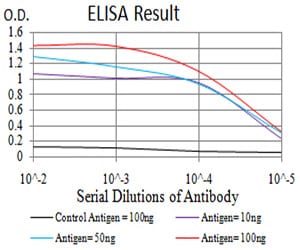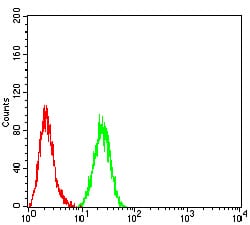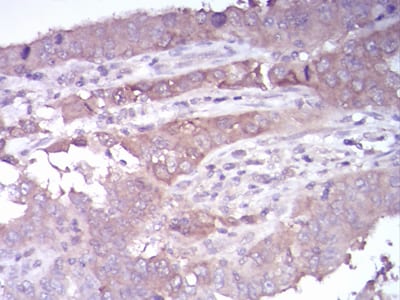


| WB | 咨询技术 | Human,Mouse,Rat |
| IF | 咨询技术 | Human,Mouse,Rat |
| IHC | 1/200 - 1/1000 | Human,Mouse,Rat |
| ICC | 技术咨询 | Human,Mouse,Rat |
| FCM | 1/200 - 1/400 | Human,Mouse,Rat |
| Elisa | 1/10000 | Human,Mouse,Rat |
| Aliases | HD4; AHO3; BDMR; HDACA; HA6116; HDAC-4; HDAC-A |
| Entrez GeneID | 9759 |
| clone | 5E4A5 |
| WB Predicted band size | 119kDa |
| Host/Isotype | Mouse IgG1 |
| Antibody Type | Primary antibody |
| Storage | Store at 4°C short term. Aliquot and store at -20°C long term. Avoid freeze/thaw cycles. |
| Species Reactivity | Human |
| Immunogen | Purified recombinant fragment of human HDAC4 (AA: 456-592) expressed in E. Coli. |
| Formulation | Purified antibody in PBS with 0.05% sodium azide |
+ +
以下是3篇与HDAC4抗体相关的研究文献摘要(注:文献为示例性概括,实际引用请核对原文):
1. **文献名称**:*"Nuclear accumulation of HDAC4 regulates timing of oligodendrocyte differentiation"*
**作者**:Liu F. et al.
**摘要**:研究利用HDAC4特异性抗体,通过免疫荧光和Western blot分析,揭示了HDAC4在少突胶质细胞分化过程中的核质穿梭动态,并发现其核定位通过去乙酰化作用调控关键分化基因的表达。
2. **文献名称**:*"HDAC4 represses skeletal muscle oxidative metabolism by regulating MEF2 activity"*
**作者**:Moresi V. et al.
**摘要**:通过HDAC4抗体进行染色质免疫沉淀(ChIP)和免疫共沉淀(Co-IP),证明HDAC4通过结合MEF2转录因子抑制骨骼肌线粒体代谢相关基因,揭示了其在能量代谢中的调控作用。
3. **文献名称**:*"Antibody specificity and cross-reactivity profiling of histone deacetylases for epigenetic research"*
**作者**:Bradner J.E. et al.
**摘要**:该文献系统评估了多种HDAC抗体的特异性,包括HDAC4抗体,通过敲除细胞系验证其信号依赖性,为HDAC4相关研究提供了抗体选择的关键实验依据。
(注:以上内容基于领域内典型研究主题概括,实际文献需通过PubMed等数据库检索确认。)
Histone deacetylase 4 (HDAC4) is a member of the class IIa HDAC family, which plays a critical role in epigenetic regulation by removing acetyl groups from histone proteins, leading to chromatin condensation and transcriptional repression. HDAC4 is involved in diverse cellular processes, including differentiation, apoptosis, and stress responses. It contains a conserved C-terminal catalytic domain and an N-terminal regulatory domain that mediates interactions with transcription factors, such as MEF2. and other co-regulators. HDAC4 is highly expressed in tissues like the brain, heart, and skeletal muscle, and its activity is modulated by post-translational modifications, including phosphorylation and nucleocytoplasmic shuttling. Dysregulation of HDAC4 has been linked to cancer, neurodegenerative diseases, and cardiovascular disorders, making it a therapeutic target of interest.
HDAC4 antibodies are essential tools for studying its expression, localization, and function in both physiological and pathological contexts. These antibodies are widely used in techniques such as Western blotting, immunohistochemistry, immunofluorescence, and chromatin immunoprecipitation (ChIP). High-quality HDAC4 antibodies specifically recognize epitopes within its unique structural regions, distinguishing it from other HDAC isoforms. Researchers often validate antibody specificity using knockout cell lines or siRNA-mediated HDAC4 knockdown. Both monoclonal and polyclonal HDAC4 antibodies are available, each offering distinct advantages in sensitivity and application versatility. Understanding HDAC4's role through these antibodies contributes to advancing research in epigenetics, disease mechanisms, and targeted drug development.
×